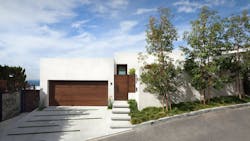This article first appeared in the March/April 2025 issue of Pro Builder.
In the aftermath of the recent Los Angeles fires, communities across the city are faced with the challenging task of rebuilding. As natural disasters become increasingly common, the cycle of destruction and reconstruction is becoming all too familiar.
Abeer Sweis, founding partner of design and construction firm SweisKloss, in Santa Monica, Calif., hopes to change this process by building homes that are better equipped to withstand natural disasters. By designing homes more thoughtfully from the outset, with the environment in mind and a focus on resiliency, Sweis’ goal is to create homes that are safe and durable while still keeping clients’ needs at the forefront of the process.
PRO BUILDER: What drew you to architecture and how did resiliency become a focus in your work?
Abeer Sweis: Contributing to good architecture has been on my mind from the beginning. It’s not just about resilience; [a home] first has to fit the client’s needs, and it needs to last. You have to maintain it, but you also have to make sure a home feels timeless and like it can grow with you as your family grows. It’s about being thoughtful, and with that comes sustainability and resilience, and all of those things.
PB: What’s your process for creating thoughtful designs that prioritize resilience?
AS: It depends on where the properties are and the specific conditions ... whether it’s on an upslope or flat land or a downslope.
Most of the time, you start with the site planning and see what you can do. Places like the Alphabet Streets in the Pacific Palisades have very small lots, but with larger properties, there’s more variability.
On larger sites, you can actually add more defensible space and be a little more thoughtful about [how you do] that.
RELATED
- 7 Ways to a Wildfire-Prepared Home
- 3 Factors That Amplify a Building's Resilience
- How to Design a 100-Year Home Built to Last
We start with the site and then go right into figuring out the materials we’re using … whether it’s stone or stucco or some other material that has a Class A fire rating.
PB: You mentioned defensible space. What exactly is that and how do you implement it in your designs?
AS: It’s a really hard thing for people because everybody is so used to having beautiful plants growing right up against their homes. Creating defensible space literally involves clearing that space.
If you kept all of the plants and dead grass and everything else 5 feet away from your house, then there’s nothing that can catch fire right there.
PB: Is it ever challenging to meet a client’s needs while still making sure you are building responsibly?
AS: All the time. I get people who really love East Coast– or Cape Cod–style homes. Many grew up with that [aesthetic] and then moved to California, and they’re still very much drawn to that style. To them, it feels like home, so that’s going to be a struggle. And there are going to be [designers] who will give them that.
That’s my bigger struggle internally—that there are going to be a lot of people who will rebuild but who won’t do so thoughtfully because they don’t know any better.
PB: How do you work around that?
AS: I don’t expect people to know this stuff. It’s the industry and the contractors and the developers. I think it’s just easier to tell people what they can’t do in a bigger, more generalized way.
PB: Designing around wildfires is clearly a major part of your work, but are there other natural disasters your firm is taking into consideration?
AS: We’ve been getting a lot more rain than California is used to seeing, so we’re thinking differently about that now. It was a wake-up call for us that we can get this type of severe weather.
PB: What do you want people to know about resilient building practices?
AS: We need to think projects through and be innovative and figure out ways we can make these communities more resilient both for the community and for our clients. A lot of it is just being curious and stopping to think for a minute before proceeding with what you already know. Learn about new materials. There’s so much that has changed. We should be the knowledgeable ones that are presenting options to our clients.


